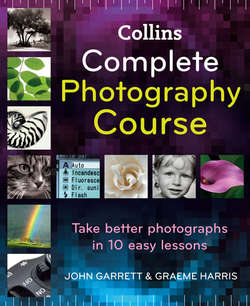Читать книгу Collins Complete Photography Course - John Garrett, Graeme Harris - Страница 5
The story of photography
ОглавлениеThe history of photography, in terms of the understanding that light passing through an aperture can create an image, is a long one. However, it is only in relatively recent decades that photography has become so ubiquitous.
It was the Greek philosopher Aristotle (384-322 BC) who first noticed the phenomenon that light rays converge to pass through small holes and, on striking a surface behind them, produce an inverted image. However, it was not until the 16th century that the camera obscura came into use. This consisted of little more than a darkened room with a hole in one wall so that an image of the outside view was projected on the wall opposite the hole. The pinhole cameras that are still used today by a growing band of adherents are in fact a miniaturized camera obscura.
Who succeeded in making the first photograph is still argued over. In France, Joseph Nicéphore Niépce and Louis Daguerre collaborated in experiments in photography, but it was only in 1839, after the death of Niépce, that Daguerre published his technique. Around the same time, in England, William Fox-Talbot invented the first negative/positive process. It was then possible to make any number of prints from one negative – basically the same process that we use today.
Photography took off with an enthusiasm in the Victorian era that is hard to imagine today. By 1853 New York alone had 80 professional studios, while London and Paris had similar numbers. Outside the studio environment, the effort that was required in those early days when photographers set out to record our world would seem extraordinary to us today, when we can just throw our cameras over our shoulders or slip them in our pockets.
The early travelling photographers needed a horse and cart to carry the very large and heavy glass plates and light-sensitive emulsion used to coat them in a lightproof tent, plus the tripod and heavy wooden cameras. Some of those photographers, the equivalent of the photojournalists of today, carried 45 kg (100lb) of gear in backpacks up mountains and into war zones. Men such as Mathew Brady, who recorded the American Civil War, were tough and talented people.
To combine the ancient pinhole camera with the latest digital technology, I drilled a hole in a camera body cap (black card would have sufficed). I then made a pinhole in a piece of kitchen foil and taped it over the hole in the cap. The image of the garden table and chairs were just visible in the viewfinder. I used a high ISO speed on the camera to keep the exposure time short. This was a very simple pinhole, but a very sophisticated pinhole camera. GH
Although this technology seems very crude and clumsy compared to the DSLR photography of today, our forefathers produced a great archive of pictures of beauty and extraordinary technical quality. The glass plates and, later, 10 × 8 inch film negatives were capable of recording exquisite detail and tone, but by its very complicated, expensive, bulky and time-consuming nature photography remained something largely beyond the reach of the general public.
The revolution that gave photography to the masses was in 1888, when George Eastman, through his Kodak company, marketed a camera loaded with film to take 100 pictures. When all were exposed the camera was sent back to Kodak for processing and printing. Kodak’s slogan ‘You take the pictures and we do the rest’ was a sensational success. Once colour negative film was invented, the photographic world was transformed and people set about documenting their everyday lives, recording holidays, parties and portraits.
The most recent technological leap has of course been digital photography, which has democratized the medium still further by making it both easier and cheaper. Nonetheless, no matter how far photography evolves, the same principles will apply – it is the confluence of light, a lens and a creative mind that will bring about great images.
A family portrait from the original Kodak ‘you take the pictures and we do the rest’ period of mass enthusiasm for photography. Unlike today’s rectangular framing, the pictures were the full circle produced by the lens.
Now everybody takes a camera on holiday, but as recently as 25 years ago this gentleman would set up his great wooden plate camera in front of all the great historic sites in Paris. Tourists would pose for photographs they could take home to remind them of their travels.
